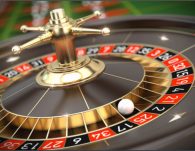
Quote from a Las Vegas gambler: “I hope I break even this week. I need the money.”
A roulette wheel is divided into 38 sections, numbered from 1 to 36, 0 and 00. 18 of the sections numbered from 1 to 36 are black and 18 are red. The sections 0 and 00 are green.
You can bet on individual numbers, combinations of numbers, or colors, before the wheel is spun, by placing chips in appropriate sections on the betting layout
The wheel is spun by a casino employee, who then spins a ball along the wheel in the opposite direction. The ball comes to rest in one of the 38 sections, which then becomes the winning section. Players who bet on the winning section are paid off accordingly. For example, a winning bet on #17 pays 35 to 1 odds. A winning bet on red sections pays 1 to 1 odds, or “even money.”
What happens to the roulette gambler in repeated play?
Since the chance is 18 in 38 that the winning section will be red, the “law of averages” states that in repeated play red will come up an average of 18 times in 38 spins. Similarly, #17 will come up, on average, once in 38 spins. So if you repeatedly bet $1 on red, on average, you will win 18 times and lose 20 times in every 38 bets, for an average net loss of $2 per 38 spins = $2/38 = $.053 (5.3 cents) per bet. Likewise, since the chance is 1 in 38 that #17 will be a winning section, the law of averages states that in repeated play, #17 will come up about once every 38 spins. So if you repeatedly bet $1 on #17, on the average you will win once and lose 37 times in every 38 bets, for an average net loss (taking into account the payoff odds) of 35x$1 – 1x$37 per 38 spins, or $2/38 = $.053 per bet.
For bets like this, the player will eventually lose at the rate of 5.3% of all money bet and casino will make a 5.3% profit.
Are there any strategies that circumvent the casino’s 5.3% profit margin (sometimes called the “House Edge”). Consider the “double-down” strategy:
- On the first bet, wager $1 on red. If red comes up, you win $1. Quit.
- On the 2nd bet (if red didn’t come up on the first bet): Double your bet and bet $2 on red. If red comes up, you win $2, covering your $1 loss on the first bet and leaving you a $1 profit. Quit.
- On the 3rd bet (if red didn’t come up on the first two bets): Double your bet and bet $4 on red. If red comes up, you win $4, covering your previous $1 and $2 losses and leaving you a $1 profit. Quit.
- Etc
By the laws of chance, eventually red has to come up, at which point you quit a winner!!!
Is there anything wrong with this strategy?
Unfortunately:
All casino games have a house limit. If you encounter an unlucky streak of losses, the amount you need to bet may exceed this limit, thus causing you to not cover your losses.
Most people have a limit. If you encounter an unlucky streak of losses, the amount you need to bet may exceed this limit, also causing you to not cover your losses.
Although unlikely, if red fails to come up 15 times in a row, on the 16th bet, you must wager $32,768 in an attempt to come out $1 ahead. Most casinos will not allow such a bet.
Alas, it turns out that the double-down strategy, although deceptively appealing, is no different from other roulette bets: In the long run, the gambler will still lose at the rate of $.053 per dollar bet.
It should be noted that the double-down strategy says to quit as soon as you win. What does it mean to quit? Does it mean that as soon as you win your dollar you never come back to the roulette table again? Or does it mean to go have a drink and then start over? For most gamblers, it means the latter. Sadly, if you quit forever, you wouldn’t be a gambler anymore.

 Canvas
Canvas
 Donate
Donate
 Let's Talk!
Let's Talk!
